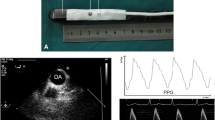Abstract
The esophageal Doppler monitor (EDM) is minimally invasive and allows for rapid and continuous cardiovascular measurements which are based upon aortic blood flow characteristics. Using a model derived from the modified Bernoulli equation, a measure of peak left ventricle (PLV) dP/dt has been developed which utilizes EDM-based parameters: PLV \(\frac{{dP}}{{2t}}\alpha \frac{{V_P^2 \cdot \sqrt {HR} }}{{T_{FC} }}\); where V p represents peak velocity of aortic blood flow, T FC is corrected flow time, and HR is heart rate. Additional clinical research is necessary to provide a correlation of this formula with invasive measurements. A wave transmission model of PLV dP/dt has also been examined. This model requires simultaneous measurement of aortic pulse wave velocity, or aortic flow wave velocity, in order to calculate PLV dP/dt. Current echocardiographic analyses of PLV dP/dt show that the wave transmission model provides better correlation with in vivo catheterization results when compared with the modified Bernoulli equation. The EDM remains a useful tool for rapid and continuous evaluation of cardiovascular indices. Further research and development, of this monitor for PLV dP/dt assessment, is warranted.
Similar content being viewed by others
REFERENCES
Atlas G and Mort T. Placement of the esophageal Doppler ultrasound monitor probe in awake patients. Chest 119: 319, 2001.
Bargiggia GS, Bertucci C, Recusani F, Raisaro A, de Servi S, Valdes-Cruz LM, Sahn DJ, and Tronconi L. A new method for estimating left ventricular dP=dt by continuous wave Dopplerechocardiography. Validation studies at cardiac catheterization. Circulation 80: 1287–1292, 1989.
Blacher J, Asmar R, Djane S, London GM, and Safar ME. Aortic pulse wave velocity as a marker of cardiovascular risk in hypertensive patients. Hypertension 35: 1111–1117, 1999a.
Blacher J, Guerin AP, Pannier B, Marchais SJ, Safar ME, and London GM. Impact of aortic stiffness on survival in end-stage renal disease. Circulation 99: 2434–2439, 1999b.
Bulpitt CJ, Rajkumar C, and Cameron JD. Vascular compliance as a measure of biological age. J Am Geriatr Soc 47: 657–663, 1999.
Carney WI, Rheinlander HF, and Cleveland RJ. Control of acute aortic dissection. Surgery 78: 114–120, 1975.
Groenink M, de Roos A, Mulder BJM, Spaan JAE, and van derWall EE. Changes in aortic distensibility and pulse wave velocity assessed with magnetic resonance imaging following beta-blocker therapy in the Marfan syndrome. Am J Cardiol 82: 203–208, 1998.
Grubb BP, Sirio C, and Zelis R. Intravenous labetalol in acute aortic dissection. JAMA 258: 78–79, 1987.
Hopkins KD, Lehmann ED, and Gosling RG. Aortic compliance measurements: A non-invasive indicator of atherosclerosis? Lancet 343: 1447, 1994.
Hunt AC, Chow SL, Escaned J, Perry RA, Seth A, and Shiu MF. Evaluation of a theoretical Doppler index to noninvasively estimate peak dP=dt using continuous wave Doppler ultrasound of ascending aortic flow in man. Cathet Cardiovasc Diagn 23: 219–222, 1991.
Kraft KA, Itskovich VV, and Fei DY. Rapid measurement of aortic wave velocity: In vivo evaluation. Magan Reson Med 46: 95–102, 2001.
Lehmann ED. Clinical value of aortic pulse-wave velocity measurement. Lancet 354: 528–529, 1999.
Lehmann ED, Hopkins KD, Rawesh A, Joseph RC, Kongola K, Coppack SW, and Gosling RG. Relation between number of cardiovascular risk factors/events and noninvasive Doppler ultrasound assessments of aortic compliance. Hypertension 32: 565–569, 1998.
Meaume S, Rudnichi A, Lynch A, Bussy C, Sebban C, Benetos A, and Safar ME. Aortic pulsewave velocity as a marker of cardiovascular disease in subjects over 70 years old. J Hypertens 19: 871–877, 2001.
Milnor WR.Hemodynamics. Baltimore,MD: Williams&Wilkens, 1982.
Mohiaddin RH, Firmin DN, and Longmore DB. Age-related changes of human aortic flow wave velocity measured noninvasively by magnetic resonance imaging. J Appl Physiol 74: 492–497, 1993.
O'Conner B and Luntley JB. Acute dissection of the thoracic aorta. Esmolol is safer than and as effecive as labetalol. Br Med J 310: 875, 1995.
Prokop EK, Palmer RF, and Wheat MW. Hydrodynamic forces in dissecting aneurysms. Circ Res 27: 121–127, 1970.
Rogers WJ, Hu YL, Coast D, Vido DA, Kramer CM, Pyretiz RE, and Reichek N. Age-associated changes in regional aortic pulse wave velocity. J Am Coll Cardiol 38: 1123–1129, 2001.
Saeian K, Wann LS, and Sagar KB. Doppler echocardiographic evaluation of left ventricular function. Echocardiography 7: 21–25, 1990.
Schertel ER. Assessment of left-ventricular function. Thorac Cardiovasc Surg 46(Suppl 2): 248–254, 1998.
Senda S, Sugawara M, Matsumoto Y, Kan T, and Matsuo H. A noninvasive method of measuring Max(dP=dt) of the left ventricle by Doppler echocardiography. J Biomech Eng 114: 15–19, 1992.
Singer M. Esophageal Doppler monitoring of aortic blood flow: Beat by beat cardiac output monitoring. Int Anesthesiol Clin 31: 99–125, 1993.
Sugawara M, Senda S, Katayama H, Masugata H, Nishiya T, and Matsuo H. Noninvasive estimation of left ventricular Max(dP=dt) from aortic flow acceleration and pulse wave velocity. Echocardiography 11: 377–384, 1994.
Author information
Authors and Affiliations
Rights and permissions
About this article
Cite this article
Atlas, G.M. Can the Esophageal Doppler Monitor Be Used to Clinically Evaluate Peak Left Ventricle dP/dt?. Cardiovascular Engineering 2, 1–6 (2002). https://doi.org/10.1023/A:1019928119187
Issue Date:
DOI: https://doi.org/10.1023/A:1019928119187




